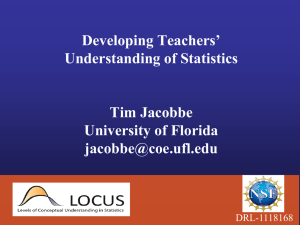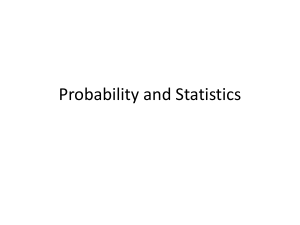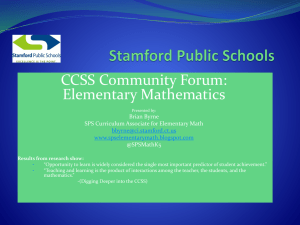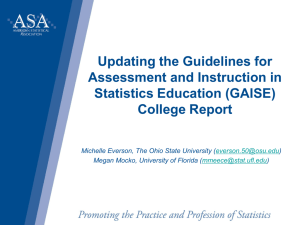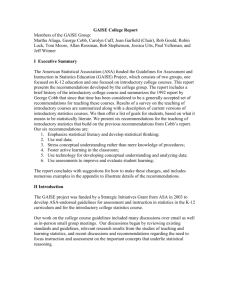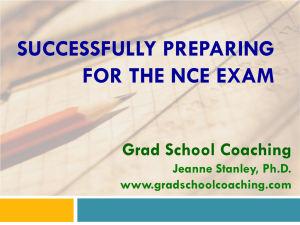Common Core, NCTM, and GAISE Statistics Recommendations for
advertisement
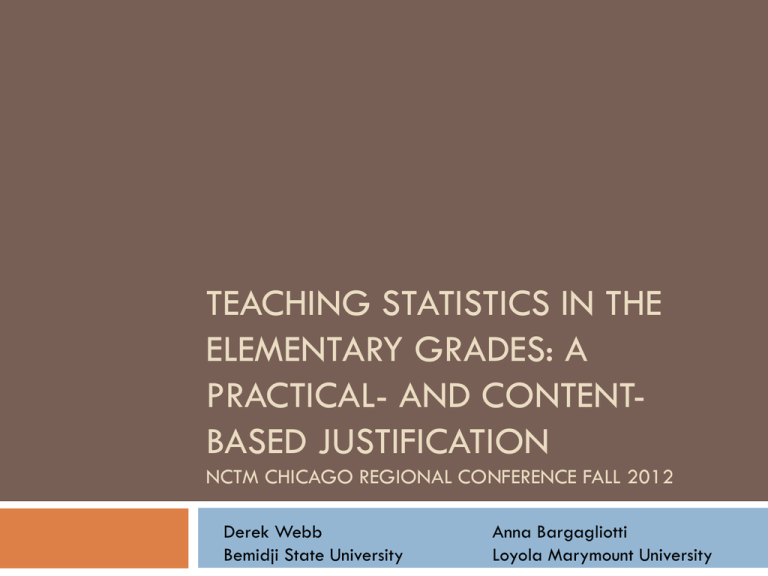
TEACHING STATISTICS IN THE ELEMENTARY GRADES: A PRACTICAL- AND CONTENTBASED JUSTIFICATION NCTM CHICAGO REGIONAL CONFERENCE FALL 2012 Derek Webb Bemidji State University Anna Bargagliotti Loyola Marymount University Statistics Education Today Over the past two decades, increasing importance has been placed on data analysis in the US Data-driven decision making and studies have drawn interest from the general population, policymakers, businesses, and schools Prominent people and news outlets have continuously touted the importance of understanding and interpreting data There is a Large Interest in Education Data For example, Secretary of Education Arnie Duncan recently commented on the use of data in the evaluation of education: “…we believe [testing] it is important to measure progress. We need to know who is ahead and who is behind – who is succeeding and who needs more support. In an ideal world, that data should also drive instruction and meaningful professional development.” -Arnie Duncan, Speech August 22, 2012 Media outlets note the importance of data in education: “Why is data so valuable in education? For one, it will advance us beyond the primary aged-based system of educational advancement that has been in place for much of the past century. By generating and enabling access to consistent streams of data from different parts of the classroom, we are no longer limited to simply knowing what students know at a point in time– we can now get a sense of when and how they learned it and how likely they are to retain and apply that knowledge” - Vineet Madan, Huff Post Education, posted June 2012 How can we prepare a statistically literate population? Statistical literacy refers to the ability to think and reason in the presence of uncertainty as well as make sense of statistical information Statistics and probability have become an integral part of mathematics K–12 education in the US NCTM includes a strand dedicated to Data Analysis and Probability throughout all grade levels The Common Core State Standards (CCSS) have deemphasized statistics in the elementary grades and increased its emphasis in middle school and high school http://www.corestandards.org/ Common Core State Standards Does this mean that elementary teachers should not know statistics? Goal today is to: Discuss practical-based reasons why it is important for elementary teachers to be well-versed in statistics Discuss content-based reasons why it is important for elementary teachers to be well-versed in statistics Audience Question 1 What grade level do you work with? A. K-2 B. 3-5 C. 6-8 D. 9-12 E. 12-16 Audience Question 2 How many courses in statistics have you taken? A. 0 B. I have not taken a course but I have taken a professional development workshop or seminar C. 1 D. 2 E. More than 2 Audience Question 3 If you have taken one or more statistics courses, how would you describe the course(s) based on what you teach: A. Very useful B. Somewhat useful C. Not useful What are practical-based reasons why teachers should be well-versed in statistics? Teacher performance and teacher pay is a hot-button issue in current educational reform debates that heavily relies on statistical methods Complex statistical models that control for variables such as the number of students in the class, student disabilities, and teacher experience can be employed in order to measure teacher performance though the performance of their students Teachers may be judged by administrators, in part, through the use of such statistical methods Teachers Need to Join the Conversation It is not be necessary for teachers to understand all the statistics involved in value-added modeling Teachers should understand the general statistical ideas surrounding educational reform Teachers at all grade levels need to have statistical understanding in order to join important conversations that effect the profession No Child Left Behind Act Policies States produce an Annual Yearly Progress (AYP) report States, school systems, and schools are issued a Report Card The Report Card lists the subjects and the assessments that are included in the evaluation for the specific state For example, in the state of Tennessee, the report card includes the Tennessee Value Added Assessment System (TVAAS) The TVAAS The TVAAS provides each teacher confidential information on each of their student’s standardized test scores on the Tennessee Comprehensive Assessment Program (TCAP) exam from grades 3 to 8 Using these performances, a teacher is presented with a predicted score for each student’s achievement during the year The TVAAS also provides information open to the public E.g., the public can access the System Value Added Report for a school district and school Statistical Information in the Reports These AYP reports contain an enormous amount of statistical information Statistical vocabulary is everywhere on the report (e.g., standards error, growth standard, three-year average, NCE) For example: NCE NCE is short for Normal Curve Equivalent The “Estimated System Mean NCE Scores” on the report shows the average district test score for each grade as an NCE value The base year is stated at the top of the report as 2009, thus all scores are equated to the 2009 scores Procedures to equate test scores are rich with statistical concepts! These procedures are not presented in the report but a teacher who has studied these procedures would have a much greater sense of what these data mean Practical Statistical Knowledge Teachers Need Teachers should be able to give meaning to assessment data Teachers should be able to make valuable assessments of their own students, classes, and schools Teachers should understand the statistics surrounding policy decisions being made in their profession Audience Question 4 Do you feel like you have a good understanding of the statistics presented in the AYP reports you receive? A. Yes B. Maybe C. No Audience Question 5 Do you receive any training on how to read the reports and the statistics involved in generating the reports? A. Yes B. Maybe C. No Audience Question 6 Do you receive any resources (including extra time) to evaluate the reports and make changes in your classroom based on the reports? A. Yes B. No C. Some, but not enough Audience Question 7 Would you find it valuable to receive more training or more background on how to read and use the reports? A. Yes B. Maybe C. No What are content-based reasons why teachers should be well-versed in statistics? Guidelines and standards exist that need to be implemented in the classroom: The Guidelines for Assessment in Statistics Education (GAISE): A Pre-K-12 Curriculum Framework report emerged from the statistics community in 2007 to provide an outline for statistics education http://www.amstat.org/education/gaise/ The CCSS Audience Question 8 Have you heard of the GAISE report? A. Yes B. No The GAISE Report GAISE defines a statistically literate person as someone who can Formulate Questions, Collect Data, Analyze Data, and Interpret Results GAISE presents a three-level (A, B, C) framework corresponding to the depth of coverage GAISE does not outline statistical learning by grade but roughly suggest: students in the elementary grades should acquire level A depth, Students in middle school should be around level B, and Students in high school should achieve level C Level A/Level B Level A is more teacher directed, Level B shifts towards being student directed Level A learning is typically contained within the classroom environment, Level B begins to expand past the student’s classroom to make assertions about other classrooms or outside the school Focus on data displays throughout The CCSS CCSS offers grade-by-grade benchmarks for K-8 and a content outline for high school CCSS contains a strand entitled “Measurement and Data” for the elementary grades CCSS focuses K-5 level statistics on three central ideas generating bar graphs taking measurements of objects and sorting drawing line plots Teaching Under the CCSS To implement the CCSS we need effective resources and examples as to what teachers should teach in the classroom It is important that the statistics being taught also be connected to GAISE CCSS covers a subset of concepts outline by GAISE GAISE provides the spirit Think Statistically! Pose a statistical question and investigate the answer Teach for CCSS using GAISE – This can be done! Bridging the Gap between Common Core State Standards and Teaching Statistics Publication which offers 21 investigations for K-12 that effectively illustrate how to present statistical material in the classroom aligned with GAISE and CCSS Website for information and purchasing publication 9 investigations are dedicated to level A understanding Investigation 2.4, “How can we sort our junk?” Statistical Question: How can we sort our junk? This lesson is aligned with 3 CCSS standards: K.MD.3 Classify objects into given categories; count the numbers of objects in each category and sort the categories by count. 1.MD.4 Organize, represent, and interpret data with up to three categories; ask and answer questions about the total number of data points, how many in each category, and how many more or fewer are in one category than in another. 2.MD.10 Draw a picture graph and a bar graph (with single-unit scale) to represent a data set with up to four categories. Solve simple put-together, take-apart, and compare problems using information presented in a bar graph. Bag of Junk How do we sort our junk? Each group has identical bags of junk Look at the junk and together discuss: What kinds of objects do you have? What type of attributes could you use as a sorting factor? How will the choice of the attribute affect the outcome of the sorting process? Choose Clothes How many articles of clothing are there? How could you sort the clothing? Make a bar graph to display your results Example Graphs Example Graphs Interpreting Results Why did your group choose the sorting attribute you selected? How did you determine the categories for your attribute? Are the graphical displays of the groups similar? How are they similar? How are they different? Provide an answer to the original question: “How can we sort our junk?” by summarizing: how you displayed your data what graphs you created what you learned about the type of junk you have through the process of sorting Could We Have Met the CCSS a Different Way? Example: Miss Smith’s students have 6 dogs, 4 cats, and 7 fish for pets. Please create a bar graph of this data. Take-away There are both content and practical reasons for elementary teachers to be prepared to think statistically Although there in not a large emphasis on statistics in the CCSS elementary grades, it is still very important that teachers be well-versed in statistics The introduction of statistical thinking begins in the elementary grades thus elementary teachers play a key role Using the GAISE spirit to teach the CCSS will ensure that students have a good foundation in statistical thinking The teaching profession is filled with statistics The more teachers understand data, the more they can contribute to policy discussions Thank you! Questions? Derek Webb Bemidji State University DWebb@bemidjistate.edu http://faculty.bemidjistate.edu/dwebb/ Anna E. Bargagliotti Loyola Marymount University abargagl@lmu.edu www.project-set.com
